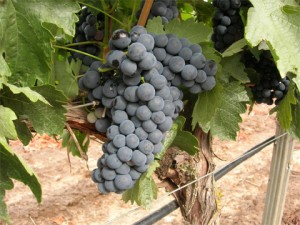The “Who’s Your Daddy” series takes a brief look at the parentage of grapes, in order to get a better understanding of where particular varietals come from and how they are genetically related to one another. So far, we’ve covered: Cabernet Sauvignon, Syrah, Chardonnay, Petit Verdot, Sangiovese, Nebbiolo, Pinotage, Gamay, Petite Sirah, and Merlot. Feel free to click on any one of the varietal names to read all about their parentage.

http://i.images.cdn.fotopedia.com/flickr-2559447601-hd/Tokyo_and_Vicinity/Places_of_Interest/Museums__Galleries/Miraikan/DNA.jpg
The subject of today’s “Who’s Your Daddy” post is Tempranillo, a grape that for some reason always makes me roll my r’s a little bit longer than I probably should!
History
The name “Tempranillo” is well accepted to be derived from the word “temprano”, meaning early, which is likely related to the early ripening of the grape. The word “Tempranillo” was recorded only sporatically through its early history, but it’s thought that the grape has been around at least since the 13th century and perhaps earlier. Tempranillo hails originally from Spain, and has been the predominant grape in wines from both Rioja and Ribera del Duero. In fact, Tempranillo is mostly grown in Spain, though you will find Tempranillo vineyards in other small corners of the world, including the United States, South America, South Africa, New Zealand, Australia, Argentina, and a few others.
After spending potentially hundreds of years in Spain, the grape may made its way to (*Edit: South) America some time during the 17th century by the Spanish Conquistadors. More than likely, the Conquistadors brought the vines over by seed, which allowed the grape to slowly establish itself in places that were more hospitable to the conditions needed for optimal growth. Tempranillo finally reached the west coast of the United States by the early 1900s, though it took some time for it to popularize and establish due to its “disagreement” with the growing conditions of the area and its desired viticultural requirements.
Viticulture
For ideal ripening and development, Tempranillo vines prefer hot days and cool nights, a combination that is not found in every viticultural growing area. *Edit: A great comment left by Earl at the end of this post reminded me that another very important characteristic of Tempranillo viticulture is that it has a short growing season.
Tempranillo does best in calcareous clay soils, though also does well in soils rich in iron, chalk, and limestone. As with many grapes, sloping terrain is beneficial for drainage, and it tends to do well at higher altitudes.
Tempranillo is prone to attack by a variety of pests and diseases, since it does not have immunity to any sort of ailment. Though the thick dark skin provides some protection again disease, the very tight cluster formation is very attractive for critters than want to set up camp and go to town on the grapes and grapevines.
Sensory Characteristics
Tempranillo is often used in blends (think Rioja, etc), though is thought to be the solid backbone of these blends to provide color and unique flavor contributions to the finished wine. Anthocyanin levels in Tempranillo grapes are very high, which explain the deep red color of the wine.
In younger Tempranillo wines, the grapes of which were grown in cooler climates, the aromatic profile tends to consist of red fruit flavors, including strawberries, black currants, and cherries. On the other hand, in older wines, the grapes of which were grown in hotter climates, the aromatic profile is reminiscent of prunes, chocolate, and tobacco. Tempranillo also often has a characteristic “earthy minerality” to its flavor profile.
In regards to structure, Tempranillo wines tend to be low in acidity, with moderate to high levels of tannin and moderate levels of alcohol. As a result of these characteristics, Tempranillo has a generally smooth mouthfeel, as well as rich aromas and flavors. Finally, Tempranillo is known to do very well in oak, as the vanilla and coconut characteristics of the oak complement the fruit and minerality components of the Tempranillo wine very well.
So, Tempranillo….”Who’s your daddy?”…
We know where Tempranillo came from originally, however, which grapes gave rise to the Tempranillo grape to begin with?
Researchers at the CSIC Universidad de La Rioja, Gobierno de La Rioja and the Instituto Madrileño de Investigación y Desarrollo Rural, Agrario y Alimentario (IMIDRA) recently uncovered the genetic origins of Tempranillo by genotyping analysis for SNP and microsatellite markers in grapevine germplasm collections and published their work just one month ago in the American Journal of Enology and Viticulture.
Without further ado, I present to you the genetic parents of Tempranillo:
Albillo Mayor…..
…and…
…..Benedicto!
Neither of these grapes is particularly well known in the United States, though Albillo Mayor is still well-established in the Iberian Peninsula of Spain. Benedicto, on the other hand, is rarely cultivated today and is not very well known even in the historical record.
There you have it! If you’d like to learn about the parentage of another grape variety, simply leave a comment below and I’ll see what I can dig up! Note: there are many grape varieties with unknown parentage still, but I’ll try my best to find data that may suggest particular relationships and origins. This type of genetic research is ongoing, so even if I can’t find information on a particular grape of your choosing today, that may change in the future!
Cheers!
(Citation for the genetics research article: Ibáñez, J., Muñoz-Organero, G., Zinelabidine, L.H., de Andrés, M.T., Cabello, F., and Martínez-Zapater, J.M. 2012. Genetic origin of the grapevine cultivar Tempranillo. American Journal of Enology and Viticulture. ajev.2012.12012 published ahead of print August 17, 2012.)
(Source for article citing possible introduction of Tempranillo seeds to South America: http://www.ejbiotechnology.info/content/vol6/issue3/full/11/index.html)



10 comments for “Who’s Your Daddy?: Tempranillo”